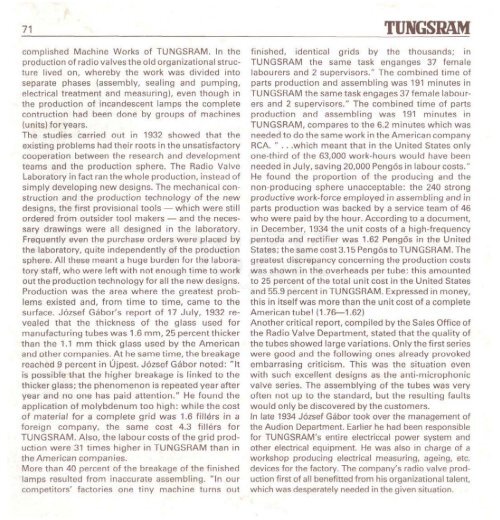THE HISTORY OF TUNGSRAM 1896-1945 - MEK
THE HISTORY OF TUNGSRAM 1896-1945 - MEK
THE HISTORY OF TUNGSRAM 1896-1945 - MEK
- No tags were found...
You also want an ePaper? Increase the reach of your titles
YUMPU automatically turns print PDFs into web optimized ePapers that Google loves.
71 <strong>TUNGSRAM</strong>complished Machine Works of <strong>TUNGSRAM</strong>. In theproduction of radio valves the old organizational structurelived on, whereby the work was divided intoseparate phases (assembly, sealing and pumping,electrical treatment and measuring), even though inthe production of incandescent lamps the completecontruction had been done by groups of machines(units) for years.The studies carried out in 1932 showed that theexisting problems had their roots in the unsatisfactorycooperation between the research and developmentteams and the production sphere. The Radio ValveLaboratory in fact ran the whole production, instead ofsimply developing new designs. The mechanical constructionand the production technology of the newdesigns, the first provisional tools — which were stillordered from outsider tool makers — and the necessarydrawings were all designed in the laboratory.Frequently even the purchase orders were placed bythe laboratory, quite independently of the productionsphere. All these meant a huge burden for the laboratorystaff, who were left with not enough time to workout the production technology for all the new designs.Production was the area where the greatest problemsexisted and, from time to time, came to thesurface. Jozsef Gabor's report of 17 July, 1932 revealedthat the thickness of the glass used formanufacturing tubes was 1.6 mm, 25 percent thickerthan the 1.1 mm thick glass used by the Americanand other companies. At he same time, the breakagereached 9 percent in Ujpest. Jozsef Gabor noted: "Itis possible that the higher breakage is linked to thethicker glass; the phenomenon is repeated year afteryear and no one has paid attention." He found theapplication of molybdenum too high: while the costof material for a complete grid was 1.6 fillers in aforeign company, the same cost 4.3 fillers for<strong>TUNGSRAM</strong>. Also, the labour costs of the grid productionwere 31 times higher in <strong>TUNGSRAM</strong> than inthe American companies.More than 40 percent of the breakage of the finishedlamps resulted from inaccurate assembling. "In ourcompetitors' factories one tiny machine turns outfinished, identical grids by the thousands; in<strong>TUNGSRAM</strong> the same task enganges 37 femalelabourers and 2 supervisors." The combined time ofparts production and assembling was 191 minutes in<strong>TUNGSRAM</strong> the same task engages 37 female labourersand 2 supervisors." The combined time of partsproduction and assembling was 191 minutes in<strong>TUNGSRAM</strong>, compares to the 6.2 minutes which wasneeded to do the same work in the American companyRCA. " . . .which meant that in the United States onlyone-third of the 63,000 work-hours would have beenneeded in July, saving 20,000 Pengos in labour costs."He found the proportion of the producing and thenon-producing sphere unacceptable: the 240 strongproductive work-force employed in assembling and inparts production was backed by a service team of 46who were paid by the hour. According to a document,in December, 1934 the unit costs of a high-frequencypentoda and rectifier was 1.62 Pengos in the UnitedStates; the same cost 3.15 Pengos to <strong>TUNGSRAM</strong>. Thegreatest discrepancy concerning the production costswas shown in the overheads per tube: this amountedto 25 percent of the total unit cost in the United Statesand 55.9 percent in <strong>TUNGSRAM</strong>. Expressed in money,this in itself was more than the unit cost of a completeAmerican tube! (1.76—1.62)Another critical report, compiled by the Sales Office ofthe Radio Valve Department, stated that the quality ofthe tubes showed large variations. Only the first serieswere good and the following ones already provokedembarrasing criticism. This was the situation evenwith such excellent designs as the anti-microphonicvalve series. The assemblying of the tubes was veryoften not up to the standard, but the resulting faultswould only be discovered by the customers.In late 1934 Jozsef Gabor took over the management ofthe Audion Department. Earlier he had been responsiblefor <strong>TUNGSRAM</strong>'S entire electriccal power system andother electrical equipment. He was also in charge of aworkshop producing electrical measuring, ageing, etc.devices for the factory. The company's radio valve productionfirst of all benefitted from his organizational talent,which was desperately needed in the given situation.








![Letöltés egy fájlban [4.3 MB - PDF]](https://img.yumpu.com/50159926/1/180x260/letaltacs-egy-fajlban-43-mb-pdf.jpg?quality=85)







